By Kathy Packman.
Lulu was certainly not one of the drop-dead gorgeous horses whose photos we see plastered all over social media. An Oldenburg/Appaloosa cross, her Appaloosa side came out glaringly, not only in her coat pattern and mottled skin, but also in the classic scrubby Appaloosa mane and tail, a throwback to the origins of the breed. She was once described as “interesting-looking” by one of our kids at camp, which may have been the most complimentary comment on her looks that she had ever received. But the first time trainer Gwen Swanbom set eyes on the young mare, she saw beyond her looks and noticed her athleticism and the potential that she possesssed. Four years ago, fourteen-year-old Carliss Sampognaro began riding the then six-year-old mare and quickly came to share Gwen’s faith in Lulu’s abilities. Thus began a story of love and devotion between a girl and a horse which eventually saved Lulu in a battle for her life which no one involved will ever forget.
Lulu and Carliss:
It was obvious from the beginning that Carliss and Lulu were a great match. By 2014, they were successfully showing 2’6” jumpers, usually placing 1st, 2nd, or 3rd. In 2015, the pair continued showing in 2’6” – 3’ jumpers, and also began their eventing career. Qualifying for the championship their first year, they earned an impressive 5th place in the Area V Beginner Novice Championships at the Holly Hill Horse Trials. In 2016, they moved up to Novice, earning enough points by summer’s end to become SEDA Junior Novice Champion at schooling horse trials and SEDA Junior Novice Reserve Champion at recognized horse trials for the year.
Then, in late summer of 2016, everything changed. About a week after coming home from a show, Lulu appeared to have a fungal infection on her right front leg. Carliss began treating it, but it began to show some swelling, and she called Dr. Damon Odom. He said it looked like she had developed a bacterial infection and prescribed penicillin. The swelling went down, and she seemed fine until a few days later when they were schooling cross country. Although there was no apparent lameness, Carliss said that something about her gait that day just didn’t feel right.
A couple of days later, another mare, Stella, began showing some lameness, which appeared to be the beginning of a hoof abcess. By the next day, Stella was beginning to exhibit more pain, even occasionally lying down in her stall. Being the weekend, we continued to treat it as an abcess, with the plan of calling the vet on Monday if it had not resolved. However, that evening, Stella lay down in her stall and would not get up, so Dr. Odom was called. Upon examination, all of her vital signs appeared normal, but she had begun having some muscle tremors, and her inability to rise made him consider the possibility of it being rhabdomyolysis or polysaccharide storage myopathy, or possibly something neurological. Dr. Odom did bloodwork, which appeared normal, and in the meantime basically treated her for everything, hoping that something would hit the mark. Unfortunately, not long after the veterinarian administered the various treatments, the mare began having seizures, which increased in frequency during the night, and so the decision was made to put her down. With the advent of the seizures, all signs were now pointing to something neurological, with the possibility of West Nile virus being foremost, even though she was current on the vaccination.
Later that afternoon, we happened to notice that Lulu was frequently lying down in the pasture, and so we brought her to the barn to check her out, and noted that her gait was slightly abnormal in a way that appeared to be neurological. Fearing a second case within hours of the first one, we hurriedly called Dr. Odom. His examination confirmed our suspicions of it appearing to be neurological, but as she was still on her feet and not nearly as critical as Stella, he felt that most of her signs pointed to a possibility of EPM. He drew blood, and instructed us to begin treatment for EPM, but within 30 minutes of his departure from the barn, Lulu went down in her stall and began having muscle tremors exactly as Stella had done. We managed to get her back on her feet, and at this point, the decision was made to immediately take her to LSU where further diagnostic testing procedures would be readily available and critical care could more easily be administered. Prayers were answered, and Lulu survived and was still on her feet at the end of the five-hour trip to Baton Rouge. Gwen and Dr. Odom gave the history of both Stella’s and Lulu’s symptoms to the veterinarians at the LSU clinic, and they began treating her for the neurological symptoms with intravenous DMSO. The LSU vets also began testing for any possible cause of the symptoms, initially agreeing with Dr. Odom that the most likely cause was West Nile.
The weekend that all of this was happening, Carliss happened to be on a trip to check out Auburn University as a possible college choice. Upon returning, she quickly made plans to head to Baton Rouge along with her mother, Connie, to be near her beloved horse. Over the next few days, Lulu made some slight improvement, in that the muscle tremors were somewhat reduced and she remained on her feet, but she was not eating well and still appeared to be far from normal. Test results began to come back, ruling out West Nile, EHV, and EPM, and by Wednesday, to our great relief, anything communicable had been crossed off the list. Carliss had begun to do her own internet research into Lulu’s symptoms, and upon reading about the neurological effects of botulism, remembered that Stella and Lulu had been stalled next to each other at the show earlier in the month, and that there had been some old, bug-infested hay in the stalls when they first put the horses in. By the time they noticed it and removed it, the horses had both taken a few bites of the hay. When asked about testing for botulism, Connie and Carliss were told that it would be very inaccurate, as it had been too long since any possible exposure. When Connie inquired about giving Lulu the botulism antitoxin as a precaution, she was told that they did not think it necessary, and, in fact, by this time they were leaning more toward believing it was something musculo-skeletal in origin. And although we who had witnessed Stella’s seizures and watched Lulu’s progression of symptoms heartily disagreed, the clinicians discontinued the neurological treatments and proceeded to do bone scans and a muscle biopsy, none of which showed anything remarkable. On Sunday, one week after arriving at LSU, they sent Lulu home, still without a firm diagnosis. She had lost about 200 pounds, but the muscle tremors had abated, and she had begun eating better. Then on Thursday, part 2 of the nightmare began.
Early Thursday morning, the first person at the barn noticed that Lulu was down and couldn’t seem to rise, and she appeared to have facial paralysis on the right side. Sara immediately called Gwen up to the barn, and, upon checking Lulu, Gwen quickly called Carliss and Dr. Odom. As soon as enough help arrived, tow straps were put around her and the bucket on the tractor was used to lift her to her feet. As she was unable to completely support herself, a temporary sling was made from a bulk feed sack, and she was supported from a beam in our covered arena. Dr. Odom began administering fluids, intravenous DMSO, and antibiotics. Throughout the next hours, “team Lulu,” an amazing group of barn friends who volunteered countless hours and weathered many sleepless nights, continued to work. She was alternately allowed to lie down and rest for periods of time, and then lifted by the tractor and supported for a time. By late afternoon, it was apparent that a decision would have to be made, and Carliss would have to be the one to make that decision. Given that her symptoms now more closely matched those of botulism, the only alternatives appeared to be putting her down or administering the antitoxin, which would have to be obtained from LSU and somehow gotten to Dubach before it was too late. At this point, Lulu had been lying completely prone on her side on the ground for a while, seeming too tired to even lift her head, and things were not looking very good. Knowing that they were all physically and emotionally exhausted, Gwen suggested that they pray for an answer. Just as Gwen ended the prayer by asking for a sign to show them what they needed to do, Lulu raised her head and looked at them all as if to say that she was not done yet. Carliss immediately made the decision to do whatever it took to get her the botulism antitoxin.
Lulu in the feed sack sling:
Connie called LSU, and arrangements were made to have the antitoxin brought from Baton Rouge by courier service, and Lulu received her first dose of the botulism antitoxin at 3 a.m. on Friday morning. Throughout the night, “team Lulu” alternately got her up and allowed her to rest, turning her over every two hours during her “rest periods” to prevent pneumonia. By mid-morning on Friday, it was obvious that Lulu was improving! She was able to stand on her own for short periods of time, and as the day went on, her standing times increased in length. For the next several days she remained in “intensive care” in the covered arena, with Carliss rarely leaving her side.
Intensive care unit:
There were usually two to four people from “team Lulu” present to help at all times, around the clock. Dr. Odom came daily, and sometimes twice a day. Lulu continued to get fluids and antibiotics and DMSO I.V. As she was still unable to rise on her own, the team was still lifting her with the tractor and turning her over during rest times. The feed bag sling was replaced by a tow strap harness made by Carliss’ father, Greg. Gradually over the next days she began to stay up longer and longer, eventually staying on her feet for hours at a time. Then, after one full week of lifting her with the tractor multiple times a day, she finally got up on her own!
Lulu in the tow strap sling:
With this huge step forward, Lulu got to move out of the “intensive care” unit of the covered arena and into a small paddock between our barns. She remained on the antibiotics and DMSO treatments and appeared to be improving daily, eating well and gaining strength over the next week or so. But when we tried to back off of the DMSO treatments, to everyone’s dismay, she began regressing, and once again was unable to rise without the aid of the tractor. It was then that we discovered that, in more progressed cases of botulism, it is recommended that two doses of the antitoxin be given, back-to-back. Since it had already been nearly two weeks since the first dose, she would need at least two more doses. So more antitoxin was ordered, and in fact, Lulu received three more doses, back-to-back. All during this time, while everyone else was riding, Carliss could faithfully be found sitting under the pecan tree with Lulu for hours at a time overseeing Lulu’s antitoxin doses or her DMSO treatments, never giving up on her. Thankfully, after these final doses of antitoxin, Lulu began to rapidly progress, and with no further episodes of regression, she began her road to recovery.
“Team Lulu”:
Although no formal diagnosis was ever made, and we can never be 100% sure of the cause, Lulu has continued to improve. To look at her now, just a few months later, the casual observer would never notice that anything had ever been wrong. She has gained back her weight, and the facial droop is gone. She has been building muscle back through daily sessions on our Equivibe and jogging up hills behind Carliss. Recently Carliss has begun taking her to Branch Farms for hydrotherapy sessions, as well. Back in the mare pasture, she has even regained her old position as alpha mare. Through it all, Lulu is a living testimony to the love, faith, hope, and prayers of a courageous young woman. And Lulu’s story is the story of how she was saved by the amazing devotion and bond that she and Carliss shared.
Lulu and Carliss show perfect form at the bank jump:

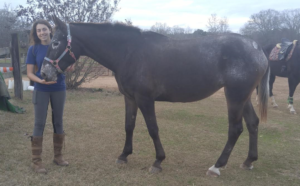
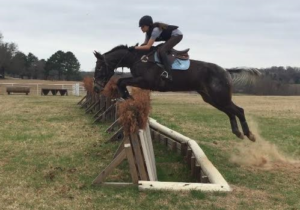
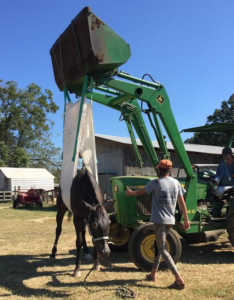
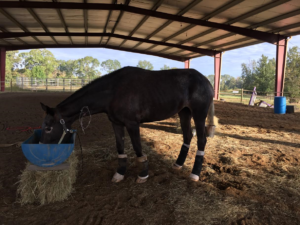
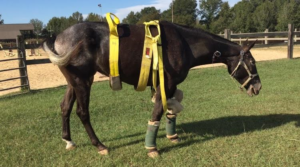
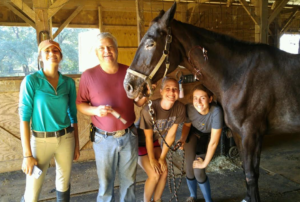
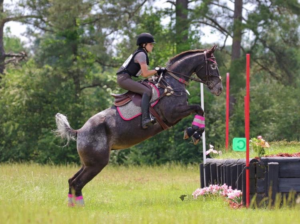


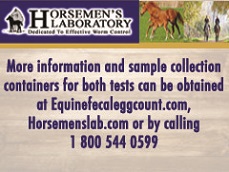
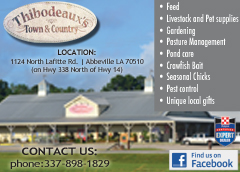

What a remarkable story and how smart was Carliss to figure out the cause of the toxin in her horse. This is truly inspirational and a wonderful happy ending.
I just loved this… I have a compassion for animals and praise Carliss for her compassion and commitment to getting her horse Lulu well. She has true love for her horse…This was such a pleasure to read and to know never give up ! Thanks Janice Spencer- Rayville,La.